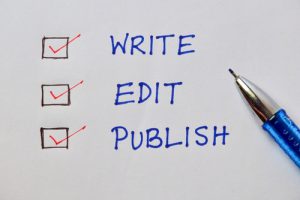When we begin writing our book, we envision it on the shelves of major bookstores sooner rather than later. We soon learn that’s not the reality of publishing. Once our eyes are opened, we often begin to think self-publishing (indie publishing) is the best option. Maybe. Maybe not.
Many of us find ourselves at Robert Frost’s proverbial “two roads diverged.” As with Frost’s roads, both paths  have their rewards and pitfalls. Let’s explore some of the details of the two paths.
have their rewards and pitfalls. Let’s explore some of the details of the two paths.
Traditional Publishing
The traditional route—sending a proposal, waiting for a response, resending the proposal—can be long, time-consuming, and often requires an agent. Finding the right agent can be as daunting as getting a publishing contract. What then are the advantages of a contract with a publishing company?
-
Advance
An advance is an upfront payment against future royalties. Many writers like the idea of having some income while writing the book. It’s like getting a paycheck before the work is performed. When the book is published, the company uses the royalties to pay back the advance. The advance payment is based on the publisher’s best guess of future sales. Unless enough books are sold for the payback, we may not see any further income. While the vision new writers have is once the contract is signed and the advance paid, the writer can spend the day in pajamas tapping away at the keyboard. The truth is, unless we are a well-known author with a following, most of us will need another source of income.
-
No upfront expense
A publishing company pays all the costs of bringing the book to market. This may sound great, but it might not be entirely true. We need to at least cover the initial editing costs, and unless we’re a famous, best-selling author, marketing is also an expense.
-
Sense of accomplishment—finally made it
At one time, self-publishing was considered to be for writers who didn’t write well enough to be published. True, some people need to learn more about writing. However, many good writers were left in the dust as well. Even now, when our accomplishments are recognized by a publishing company, we feel as though our writing and ourselves have been validated.
Not all is rosy with a publishing contract. There are also drawbacks to consider.
-
Little control
The publishing company makes most decisions about the cover, editing, formatting, and so on. Some publishing companies may look at your suggestions, but don’t count on your wonderful image making it to the front of the book. We must trust our representative at the company to make the best decisions for us.
-
Length of time to publication
After signing a contract, it may take two years or more before our book is published. Publishing companies have a routine and schedule for manuscripts. Each one follows the same steps. Some smaller publishers may move a little faster.
-
Little marketing help
We, the authors, are primarily responsible for marketing, including any expenses. Marketing begins long before the publication date. Plus, as much as we may not like social media, it’s a must.
Self-Publishing
Self-publishing is, as the name implies, taking care of the publishing details ourselves. It doesn’t mean you need to be a graphic artist to create your cover or have a professional editor. Like traditional publishing, there are pros and cons. What are the benefits of the DIY method?
-
Creative control
As the publisher, we can make all the decisions about the cover, formatting, even the type of book: ebook, print, or both.
As a self-publisher, we can choose an editor and a graphic artist with whom we work well.
-
Can be published quickly
The book will be available sooner. We’re not waiting for the wheels of the publishing company to grind through the process.
Because publishing companies release books based on a company-specific schedule, sometimes, a lesser-known writer will be bumped for a “hot” topic book. By self-publishing, we can determine the best time to release our book.
As can be expected, there are negatives to self-publishing.
-
All upfront expenses with no advance
Not only will you receive no advance, but you’ll also be responsible for all the expenses. While it’s possible to use “cheap” services, the quality may only be as good as what you pay.
-
Little marketing help
In today’s publishing world, marketing is the author’s responsibility. The same methods used for traditional publishing are available to a self-publisher.
-
Stigma
At one time, a self-published book meant the book wasn’t good enough. With the ease of publishing their books now, more well-known writers are using this method. Did you know Stephen King self-published one of his books?
Many writers set up a publishing imprint to add legitimacy to their products. I recommend contacting an attorney to see if there are legal requirements in your state.
What’s needed for traditional publishing?
Writers have several chores when using a publishing company.
-
An agent (maybe)
Some publishers require all proposals to come from an agent. Be sure to check the company’s guidelines. Pursuing an agent takes some of the same steps as landing a publishing contract. Some well-known agencies may even require a recommendation from a current client.
-
A book proposal
A book proposal has some standard parts: synopsis of the story, marketing plan, table of contents, and sample chapters. Some agents and publishers have a sample proposal on their website.
-
Building a platform
A writer’s platform is their visibility to readers. Some of the elements may be a newsletter, social media, and other publications. Platform numbers are included in the marketing section of the proposal.
-
Patience
It takes time. Traditional publishing is a waiting process. This is the reason it may take years before a book is published.
What’s needed for self-publishing?
Self-publishing is more than writing a book and uploading to an online store. Some of the chores are needed.
-
Proposal (maybe)
Writing a proposal for your book, even though you plan to self-publish, helps you hone the other facets of your needs.
-
Building a platform
As with traditional publishing, the platform should begin before and during the writing phase.
-
All of the services
You are the publishing company. You will provide the cover design, editing, formatting, and so on. It’s best to be prepared to hire professionals for these tasks.
-
Patience
Self-publishing may be faster to market, but it still requires patience. Some tasks, such as editing, take time to be well done. While waiting, continue platform building.
The choice is based on our goals for our book. Each of us must determine what is most important for our book. Most of my books have been self-published, but I do have a book with a publishing company. For each one, I’m happy with the results.
It’s not always an easy decision, but one each writer must make for themselves.
—
Susan K. Stewart teaches, writes, and edits nonfiction when not tending chickens, peacocks, and donkeys. Susan’s passion is to inspire readers with practical, real-world solutions. Susan’s first published work was a poem in her elementary school “literary” booklet. Since that humble beginning, Susan has written for newspapers, magazines, and compilations. Her books include the award-winning Formatting e-Books for Writers, Harried Homeschooler’s Handbook, Family Preparedness in the City and Suburbia, and Donkey Devos: Listen When God Speaks. In addition to being a managing editor at Elk Lake Publishing, Inc. and co-owner/administrator of The Writers View, Susan is a member of American Writers and Speakers Association, Christian Authors Network, and Proofreader and Editors Network.



